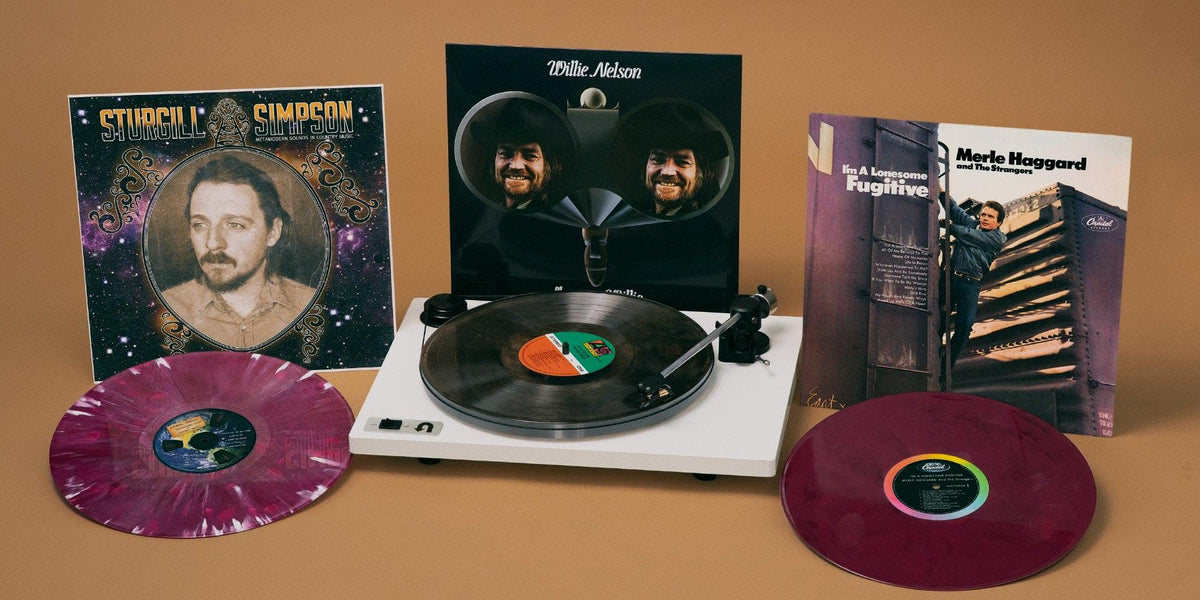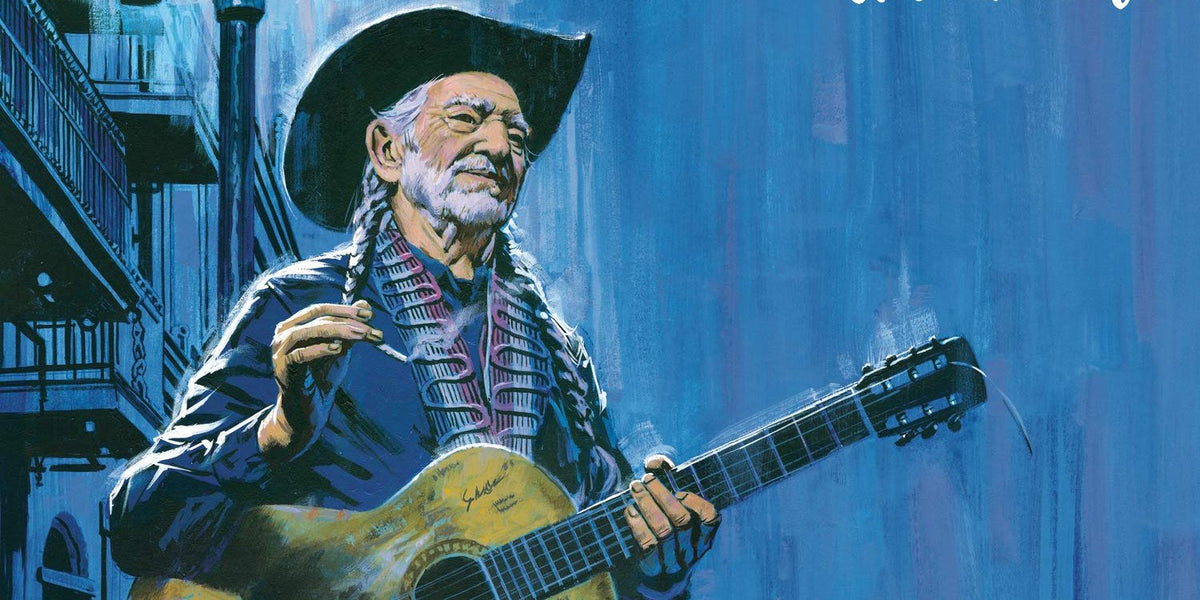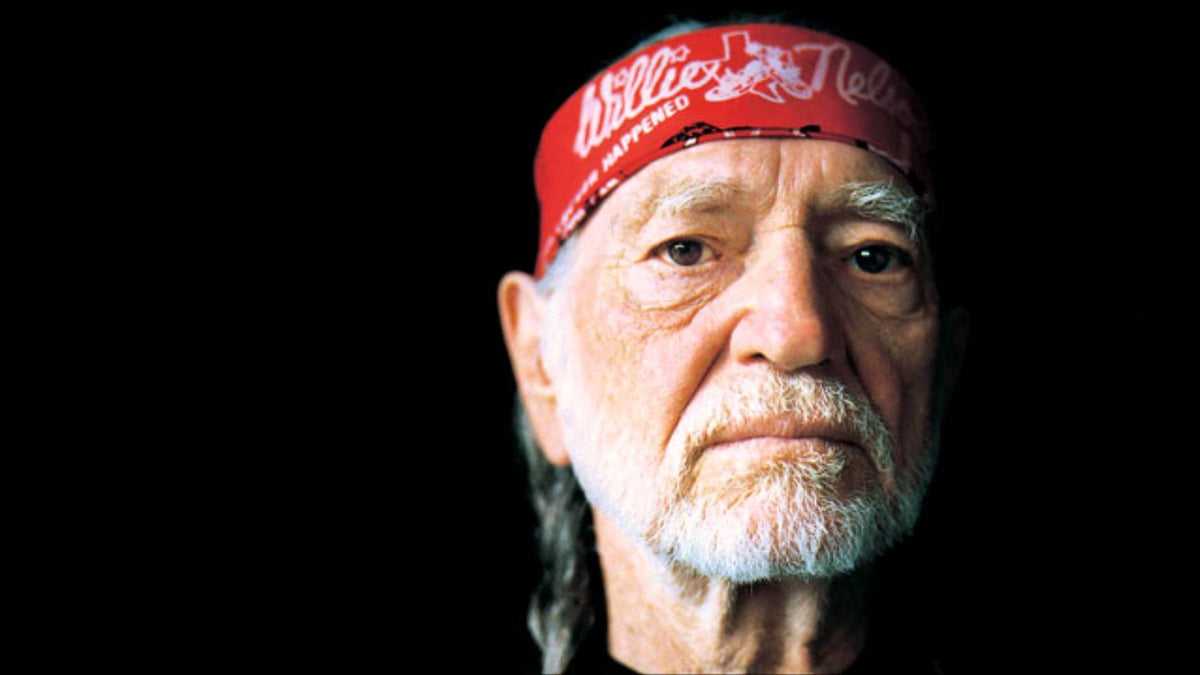Willie Nelson Got Free On 'Shotgun Willie'
Read The Liner Notes For VMP Country 2
The vision of Willie Nelson that exists in the popular imagination — the shoulder-length braided ponytail, the weed, the Outlaw on the fringes, the Zen leader of the Tao of Willie and, again, the weed — is not present on his, say, first 15 studio albums. Sure, Willie’s songwriting was strong from his debut on (the best, really), but look at that album cover. There Willie is on ...And Then I Wrote, looking less like the guy who’d change the sound, themes and mythology of country music and more like a nice young man who’d love to see you inside of a new Chrysler. Things loosen up on his third LP, Country Willie, but he’s still clean shaven, wearing bib overalls and looking like someone your square grandpa would listen to in 1965. On his eighth LP, Good Times, he’s playing golf; on the cover of his 10th, Both Sides Now, he’s wearing what looks like business casual; and it’s not until his 12th, Willie Nelson and Family, that you even get a hint that Willie isn’t like the ham’n’egger country singers who dominated the genre in the ’60s, guys who sang big-chested ballads and dressed like they were on their way to the supper club.
And it’s not until his 16th album, the one that brings us here today, that Outlaw Willie emerges: cocoon-like, ready to break every rule of country stardom. He was fed up, and done doing things like he had been told to do them, done playing by Nashville’s rules and done being forced into the Countrypolitan sound as dictated by his producers at RCA. He absconded to Austin, Texas, bro’d out with a new generation of country songwriters trying to get back to what’s real and pondered his next move. At 39, he considered retiring, saying to hell with it and heading off into the sunset.
What he’d do next would change country music forever, and help launch an entire movement. It’d make him a star, and into the Willie Nelson we all now know and love. And it started with Shotgun Willie.
Born April 29, 1933, in the throes of the Great Depression in the middle of nowhere in Texas, Willie Nelson, thanks to the vagaries of the strong AM radio towers dotting the American South that allowed you to pick up signals from far away, grew up a fan of a random assemblage of the pre- and post-war American songbook. He could quote Ernest Tubb and his hero Bob Wills, but he also revered the jazz guitarist Django Reinhardt, Duke Ellington and Frank Sinatra. He was weaned on the blues but reared on country, jumping back and forth between stations playing the Grand Ole Opry and Muddy Waters. If there’s something that ties that generation of performers — from Otis Redding to Waylon Jennings, Marvin Gaye to Merle Haggard — it was being raised on a panacea of good music, a world where you could take equal musical inspiration from the Staple Singers as you could the Carter Family.
Nelson did everything he could to make a living in music; he played first in a family band with his sister and brother-in-law as a kid, and as a teenager toured as the lead singer of a polka band. He joined the Air Force when he graduated high school, as a lot of young men did in those years, but was discharged on account of a bad back. He did some time matriculating at Baylor University, which was near where he grew up, but decided that he’d rather make a living in music instead, working an assemblage of odd jobs, bouncing between Washington state and Texas.
By 1960, he had signed a songwriter’s contract with D Records, since it turned out that the little songs he was constantly scribbling on every piece of scrap paper might be the best way for him to make a living. While working part-time as a DJ in Houston, he recorded a demo for a song called “Crazy.” He was out one night, drunk as a skunk, playing the recently recorded song on the jukebox, when someone who claimed to be Patsy Cline’s husband demanded to buy the song and get Cline to record it. Nelson barely believed it, but you probably know what happened next: In 1961, Cline released the song, and it became her song, her biggest hit and the song that everyone would remember her by, especially after her tragic, and fatal, plane crash two years later. Thanks to “Crazy,” and to Faron Young taking Nelson’s “Hello Walls” to No. 1 on the country charts the same year, Nelson got picked up by the RCA Victor machine, which bet that he’d have to turn into a country star due to his songwriting chops.
They were right, of course, but they were off by a decade, give or take. In those days, RCA popularized the “countrypolitan” sound, which took the raw grit of country music, and mainstreamed it to play in the increasingly suburbanizing South. It was a sound that could be beautiful; it added layered string arrangements and expertly crafted dynamics to songs that benefitted from those things, and made stars of names like Porter Wagoner, Bill Monroe, Hank Snow, Jimmie Rodgers, Charley Pride and a guy named Elvis Presley. However, it often meant square pegs like Nelson were forced into its sonic round holes.
Nelson’s live shows were often barrelhouse affairs, barely on the rails, and raucous and fun, showcasing the humor, sadness and wit of his songs. He wanted to make records that were raw, and spoke directly to and for the people he was performing for. That is rarely captured on his early RCA albums, since they wouldn’t let him use his touring band in the studio, instead opting for Nashville pros. But every once in a while, you get flashes of what he’d do in the ’70s. Texas in My Soul is an early career highlight, and Both Sides Now is meta in its blending of Nelson’s pinky-up songwriting side and his country standards side, since he covers both Joni Mitchell and the Carter Family. By the time of 1972’s superlative The Words Don’t Fit the Picture, Nelson was almost publicly battling RCA, who were still putting out Nelson albums in hopes something would hit, but not allowing him to make the music he wanted to make.
Nelson had reached a crossroads: His rapturously received tours would swallow up every dime of his songwriting royalties each year, and RCA wasn’t convinced Nelson would be a star, so each new album was marketed and pressed modestly, meaning it sold modestly, barely earning enough for Nelson to keep food on his table. Nelson was stifled creatively, stifled commercially, and stifled spiritually. He got so desperate, ground up in the Nashville machine, that he laid down in the street outside a dive bar and waited for someone to run him over. No one did. After The Willie Way, his 15th album, he absconded to Austin, Texas, to lick his wounds.
In late ’72, Willie Nelson was a man without a country, or more accurately, without a record label. He spent most of his time letting his manager deal with that, and hung out at Armadillo World Headquarters in Austin, Texas, a legendary honky tonk bar that had an outsized impact on country music, given its own financial straits (It never made any money, despite being the place every visiting musician demanded to play. It closed in 1980.). The ’Dillo, as it was called, was the epicenter of hippie culture in Austin, and for that matter, Texas in general. The clientele wore their hair long, smoked grass and stripped country music down to its barest essence. It regularly hosted Waylon Jennings and Willie Nelson in the early ’70s, the two men who’d invent outlaw country.
In early 1973, Nelson signed with Atlantic Records as the label’s first mainstream country artist (the label had signed alt-country godhead John Prine in 1971). Famed producer Jerry Wexler had apparently decided he’d spent enough time bringing soul music to the masses via work with Otis Redding and Aretha Franklin, and set upon establishing Atlantic’s bona fides in country music. Eventually, that would mean Nelson teaming up with the soul musicians who made Atlantic Records the best-sounding in the world — like Booker T. Jones of the M.G.’s, who produced Stardust, and Muscle Shoals’ Swampers, who’d play on multiple Nelson records. But for Shotgun Willie, it meant a little more subtle soul touches, namely having some tracks featuring the work of the Memphis Horns, Andrew Love and Wayne Jackson, who were famed for their work on basically every significant Memphis soul album of the ’60s.
When Nelson first arrived in New York in February 1973, he was like a firehose going off with material; in two days of recording, he and his band, the Family — who were recording with Nelson for the first time in the studio — along with help from fellow Outlaw Doug Sahm and his band, had recorded the entirety of The Troublemaker, an album of gospel covers that wouldn’t be released until 1976. But when it came time to record songs of Nelson originals, Willie felt backed up, and uninspired; he knew what he needed to do to record gospel covers, but when it came time to write songs for the first time completely outside of Nashville’s system, he was lost.
Then, according to Willie: An Autobiography, inspiration struck when he was sitting on the toilet in his New York hotel room: He wrote “Shotgun Willie” in his underwear on the back of an empty sanitary napkin envelope. Nelson had gotten the “Shotgun Willie” nickname for the time he brandished a shotgun to ward off his daughter’s abusive boyfriend, but “Shotgun Willie” wasn’t about that at all. Instead, it was literally about the process of writing the song “Shotgun Willie.” “Shotgun Willie sits around in his underwear / Biting on a bullet and pulling out all of his hair / Shotgun Willie's got all of his family there,” Nelson sings desperately in the chorus, before admitting in the first verse, “Well, you can't make a record if you ain't got nothing to say / You can't make a record if you ain't got nothing to say / You can't play music if you don't know nothing to play.” It seems like a simple solution to a tough problem — when you can’t figure out what to write about, write about the writing itself — but in actuality, it opened Nelson up and let him write songs about anything, which, in the nearly 50 years since Shotgun Willie, has meant that Nelson has written songs about everything. “Shotgun Willie” started Nelson down the path that led him to being the finest songwriter in 20th century music, a performer whose every song has at least one kernel of knowledge you can apply to your own life.
When Wexler heard “Shotgun Willie,” he declared that it would be the title of the album. And that confidence in Nelson led to the rest of the originals on Shotgun Willie. “Sad Songs and Waltzes” starts as an earnest, sad song about a dishonest recent lover, but turns in its first verse to be a meta-song about how songs like that, “aren’t selling this year,” and finds him telling this ex that she’s lucky he’s not a star big enough to get a song about her on the radio. “Devil in a Sleepin’ Bag,” a song about the various calamities and indiginities of touring, is played like a double entendre, but its titular Devil is actually Nelson’s longtime drummer Paul “The Devil” English (who’d play with Nelson full-time from 1966 until his death in 2020). In terms of long-ranging impact, the biggest song on Shotgun Willie is the metaphorical “Whiskey River,” which takes the salvation of rivers in gospel music and turns it into the salvation of the bottle, and in turn, inspired the name of at least one country western bar in basically every metropolitan area in the U.S.
Though the story of Shotgun Willie is one of Nelson finding his own voice after being suppressed for 15 albums, it’s also the story of an opening of the world of his records, to include songs by longtime influences and up-and-coming songwriters that would later become collaborators. For the former, he covers two songs by his heroes Bob Wills and His Texas Playboys here: the fiddle- and sax-heavy take on “Bubbles in My Beer,” a song about trying to find answers for what ails you in the mystery of the chemistry of a good lager, and “Stay All Night (Stay a Little Longer),” the biggest hit on Shotgun Willie (it hit No. 22 on Billboard’s Hot 100). And to the new collaborators, Shotgun Willie began his love affair with the songs of Leon Russell, as he covers “A Song for You” — a song covered most famously by Donny Hathaway, who, as it happens, arranged some strings on Shotgun Willie — and “You Look Like the Devil.” Russell, though he was primarily a rock singer, had instant chemistry with Nelson when they met, and they eventually covered each other’s songs and toured together, resulting in the 1979 album, One for the Road. Nelson took a lot of the sentimentality and simple, yet complex, songwriting Russell brought to ’70s rock, and filtered it through a country sensibility, the final piece of the outlaw country puzzle falling into place.
Shotgun Willie was not a huge hit, but it was the biggest-selling album of Nelson’s career at that point, successful enough that Atlantic was sure their Willie signing would pay off eventually. Later in 1973, Wexler would send Nelson to Muscle Shoals to make Phases and Stages, an album that made a much bigger splash on the charts, but which still didn’t move the kind of units Atlantic had hoped. They let Nelson leave the label, and closed their country operations without promoting the album much, and Nelson would make the seminal LPs of his career on Columbia (his run from 1975’s Red Headed Stranger through 1982’s Always on My Mind is basically flawless).
Looking back on Shotgun Willie, Nelson would remember Kris Kristofferson — who is namechecked on “Devil in a Sleepin’ Bag” — calling it his “mind farts” album, but Willie would remember it more fondly. “Maybe so, but I thought of it more as clearing my throat,” he’d write in Willie: An Autobiography. But to offer a different perspective, it isn’t either of those things: It’s the groundbreaking of the building that became Willie Nelson as we all know him now. It’s the first corner posts cleaving the dirt, the first shovel hitting bedrock, the excavation process completing. It took 16 LPs for Nelson to find himself, and he’s never been more, or less, than Willie Nelson in the 50 years since.
Andrew Winistorfer is Senior Director of Music and Editorial at Vinyl Me, Please, and a writer and editor of their books, 100 Albums You Need in Your Collection and The Best Record Stores in the United States. He’s written Listening Notes for more than 30 VMP releases, co-produced multiple VMP Anthologies, and executive produced the VMP Anthologies The Story of Vanguard, The Story of Willie Nelson, Miles Davis: The Electric Years and The Story of Waylon Jennings. He lives in Saint Paul, Minnesota.
Related Articles
Join the Club!
Join Now, Starting at $36Pages







